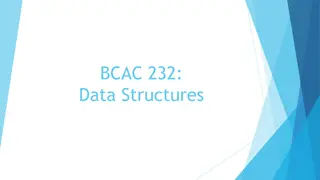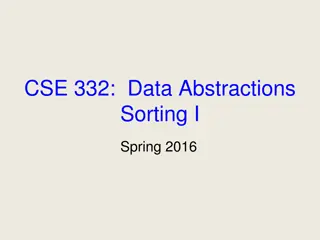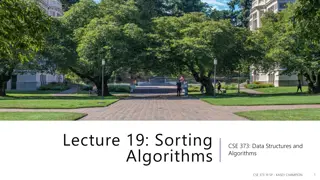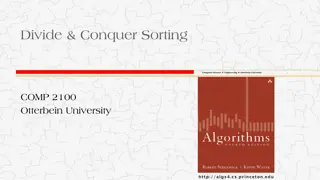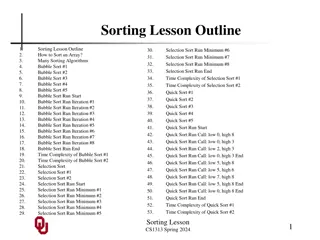
Sorting Algorithms in Computer Science
Delve into the world of sorting algorithms in computer science where multiple methods exist to arrange data efficiently. Explore techniques such as selection sort and bubble sort, understanding their complexities and performance through Big O notation analysis.
Download Presentation

Please find below an Image/Link to download the presentation.
The content on the website is provided AS IS for your information and personal use only. It may not be sold, licensed, or shared on other websites without obtaining consent from the author. If you encounter any issues during the download, it is possible that the publisher has removed the file from their server.
You are allowed to download the files provided on this website for personal or commercial use, subject to the condition that they are used lawfully. All files are the property of their respective owners.
The content on the website is provided AS IS for your information and personal use only. It may not be sold, licensed, or shared on other websites without obtaining consent from the author.
E N D
Presentation Transcript
Sorting CMSC 201
Sorting In computer science, there is often more than one way to do something. Sorting is a good example of this!
Sorting Here is a simple way of sorting a list: Find the smallest number in a list. Move that to the end of a new list. Repeat until the original list is empty. This is called selection sort selection sort!
Analysis What is the big O of finding the lowest number in a list (for a list of size N, what is the worst case number of elements you d have to look through to find the min?) For a list of size N, how many times would we have to find the min to sort the list? What is the big O of this sorting algorithm?
Analysis What is the big O of finding the lowest number in a list (for a list of size N, what is the worst case number of elements you d have to look through to find the min?) N For a list of size N, how many times would we have to find the min to sort the list? N What is the big O of this sorting algorithm? O(N2)
Bubble Sort Let s think of some other options! How about this: We look at the first pair of items in the list, and if the first one is bigger than the second one, we swap them. Then we look at the second and third one and put them in order, and so on. Once we hit the end of the list, we start over at the beginning. We keep it up until the list is sorted!
Bubble Sort [ 4, 8, 1, 10, 13, 14, 6] First pass: 4 and 8 are in order 8 and 1 should be swapped: [ 4, 1, 8, 10, 13, 14, 6] 8 and 10 are in order. 10 and 13 are in order. 13 and 14 are in order. 6 and 14 should be swapped. [ 4, 1, 8, 10, 13, 6, 14]
Bubble Sort [ 4, 1, 8, 10, 13, 6, 14] Second pass: 4 and 1 should be swapped: [ 1, 4, 8, 10, 13, 6, 14] 4 and 8 are in order. 8 and 10 are in order. 10 and 13 are in order. 13 and 6 should be swapped: [ 1, 4, 8, 10, 6, 13, 14] 13 and 14 are in order.
Bubble Sort [ 4, 1, 8, 10, 6, 13, 14] It will take two more passes over the whole list to get the six in place.
Analysis For a list of size N, how much work do we do for a single pass? How may passes will we have to do? What is the big O of bubble sort?
Analysis For a list of size N, how much work do we do for a single pass? N How may passes will we have to do? N What is the big O of bubble sort? O(N2)
Quicksort Quicksort: Start with the number on the far right. Put everything less than that number on the left of it and everything greater than it on the right of it. Quicksort the left side and the right side.
Analysis For a list of size N, how many steps does it take to move everything less than the last number to the left and everything greater than the last number to the right? How many times with the algorithm divide the list in half? What is the big O?
Analysis For a list of size N, how many steps does it take to move everything less than the last number to the left and everything greater than the last number to the right? N How many times with the algorithm divide the list in half? lg(N) What is the big O? O(Nlg(N))
Radix Sort Most of the time, O(nlg(n)) is the best we can do for sorting. However if we make the problem slightly easier, we can do even better! Imagine we know for a fact that the list we are sorting is only integers between 0 and 10.
Radix We can make an empty list filled with 10 zeroes. The first element of this list represents the number of zeroes we ve seen so far in the list we re sorting. The second number is the number of ones we ve seen, and so far. So say we have the list: [0, 3, 2, 1, 6, 8] We make our counting list: [0, 0, 0, 0, 0, 0, 0, 0, 0, 0] And iterate over the list we want to sort. The first number is a zero, so we add one to the zeroth element of our counting list: [1, 0, 0, 0, 0, 0, 0, 0, 0, 0]
Radix [0, 3, 2, 1, 6, 8] The next number is a 3, so we add one to the third element of our counting list: [1, 0, 0, 1, 0, 0, 0, 0, 0, 0] Then 2: [1, 0, 1, 1, 0, 0, 0, 0, 0, 0] Then 1: [1, 1, 0, 1, 0, 0, 0, 0, 0, 0]
Radix [0, 3, 2, 1, 6, 8] When we re done, the list looks like this: [1, 1, 1, 1, 0, 0, 1, 0, 1, 0] For an index i, we know if countList[i] == 1, there was one i in the original list. One pass over the counting list to figure out which numbers were there and we ve sorted it!
Radix We do N operations to put the zeroes in the counting list, N operations to fill the counting list, and N operations to reconstruct the sorted list. Which gives us 3N operations, which is O(N)!







